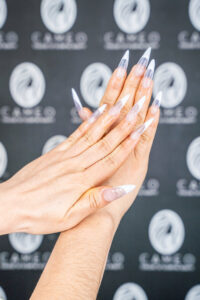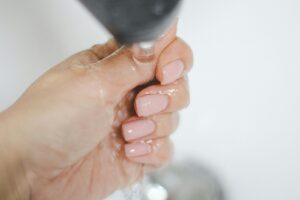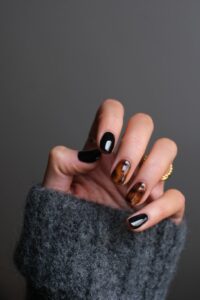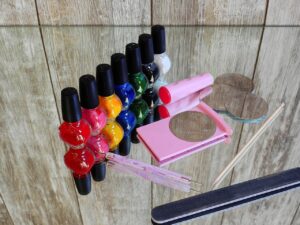How to Remove Acrylic Nails at Home Safely Without Damage
Removing acrylic nails at home can be a daunting task for many, especially when trying to do so without causing damage to your natural nails. Acrylic nails are popular for their durability and aesthetic appeal, but improper removal techniques can lead to weakened nail beds and damaged cuticles. In this article, we will explore safe and effective methods to remove acrylic nails at home, ensuring the health of your natural nails. By understanding the properties of acrylic nails and the best practices for their removal, you can maintain beautiful and healthy nails.
Understanding Acrylic Nails

What are Acrylic Nails?
Acrylic nails are a type of artificial nail enhancement made by combining a liquid monomer and a powder polymer to form a hard, protective layer over the natural nail. This mixture is applied to the nail bed and sculpted to the desired shape before it hardens, creating a strong and durable surface. Acrylic nails have become a popular choice for those looking to achieve longer, more aesthetically pleasing nails, especially for individuals with weak or brittle nails that may not grow as desired. They are known for their strength and longevity, making them a favored option in nail salons worldwide.
Benefits of Acrylic Nails
The popularity of acrylic nails is largely due to their numerous benefits. Here are some of the primary advantages:
- They offer durability by providing a protective layer over the natural nail, reducing the risk of breakage and splitting.
- Acrylic nails also offer versatility in terms of design and length, allowing individuals to customize their look with various shapes and colors.
Additionally, they serve as a great base for intricate nail art, making them a favorite among those who enjoy experimenting with different nail styles. With proper care, acrylic nails can last several weeks, providing a long-lasting beauty solution.
Common Concerns with Acrylic Nails
Despite their benefits, there are several common concerns associated with acrylic nails. One major issue is the potential damage to the natural nail bed if the acrylics are not applied or removed correctly. Frequent use of acrylic nails can also lead to weakened natural nails, making them more prone to breakage. Additionally, improper removal techniques, such as peeling or prying off the acrylic nails, can damage the underlying nail surface. There is also a concern about the use of harsh chemicals, like acetone, which, while effective in removing acrylics, may dry out the nail and surrounding skin if not used properly. It is crucial to follow safe removal practices to minimize these risks and maintain healthy natural nails.
Preparing for Acrylic Nail Removal
Gathering Necessary Supplies
Before beginning the process to remove acrylic nails at home, it is essential to gather all the necessary supplies to ensure a smooth and efficient removal procedure. Here are the key items you will need:
- Nail file
- Pure acetone
- Cotton balls
- Aluminum foil
- Cuticle pusher
For those looking to remove acrylic nails without acetone, alternative options like nail polish remover with acetone or warm soapy water can be considered. Additionally, having cuticle oil can be beneficial to keep your nails and cuticles moisturized after the removal process. By preparing these supplies in advance, you can ensure that you have everything you need to safely take off your acrylic nails without damaging your natural nail.
Assessing Your Natural Nails
Before embarking on acrylic nail removal, it is important to assess the current condition of your natural nails to minimize potential damage. Examine your nails for any signs of weakness, brittleness, or damage, which could influence the method you choose for removal. Healthy nails will often withstand removal processes better and recover faster. It is crucial to understand the state of your nail bed, as removing acrylics without considering this can lead to further harm. If you notice any significant issues, it might be wise to consult a professional to avoid exacerbating any existing problems, ensuring that your nails remain healthy and strong.
Choosing the Right Method to Remove
Selecting the most appropriate way to remove acrylic nails at home is crucial to avoid damaging your natural nails. If you prefer using acetone, soaking your nails in pure acetone is an effective method. However, if you wish to avoid acetone, consider using non-acetone nail polish remover or even warm, soapy water as alternatives. Each method requires patience and care to ensure nails come off without damage. Understanding your preferences and the condition of your nails will guide you in choosing the best removal technique. This thoughtful preparation is key to achieving safe and successful acrylic removal at home.
Methods to Remove Acrylic Nails at Home
Using Acetone for Acrylic Removal
Using acetone is one of the most effective ways to remove acrylic nails at home. Acetone works by dissolving the adhesive bonds of the acrylic, allowing it to be easily peeled away from the natural nail without causing damage. To begin, soak your nails in a bowl of pure acetone for 20-30 minutes. This soaking process helps to soften the acrylic, making it easier to remove. To protect your skin from dryness, consider applying a layer of cuticle oil around the nails before soaking. Once the acrylic is softened, gently use a cuticle pusher to remove the acrylic, ensuring you do not damage your natural nail.
Ways to Remove Acrylic Nails Without Acetone
If you prefer to remove acrylic nails without acetone, there are alternative methods that can be equally effective. One way to remove acrylic nails is by using a non-acetone nail polish remover, which is less harsh on the nail bed and surrounding skin. Another option is to soak your nails in warm, soapy water for a prolonged period, which can help to loosen the acrylic. This method requires more patience but is gentle on your nails and skin. After soaking, use a nail file or buffer to carefully file down the softened acrylic, taking care not to damage your natural nails underneath.
Step-by-Step Guide to Take Off Acrylic Nails Safely
To safely take off acrylic nails at home without damaging your natural nails, follow these detailed steps:
- Trim the length of the acrylic nails using a nail clipper.
- File the surface of the acrylic to break the seal, which will help in the removal process.
- If you are using acetone, soak cotton balls in pure acetone and place them on your nails, securing them with aluminum foil. Leave them for about 20-30 minutes.
- After soaking, use a cuticle pusher to gently remove the acrylic.
Finish by buffing any remaining residues and moisturizing your hands and nails with cuticle oil to keep your nails healthy.
Aftercare for Natural Nails

Photo by Anna Kumpan on Unsplash
How to Care for Your Natural Nails Post-Removal
After successfully removing acrylic nails at home, it’s crucial to focus on the health and recovery of your natural nails. Begin by moisturizing your hands and nails regularly with nourishing cuticle oil to replenish any lost moisture and prevent dryness. Keeping your nails trimmed and filed with a gentle nail file will help avoid breakage and maintain their shape. Incorporating a nail strengthener into your nail care routine can fortify the nail bed, promoting resilience and growth. Avoid using any harsh chemicals or excessive filing during this recovery phase to ensure your nails return to their healthy state without damage.
Signs of Damage to Look Out For
Monitoring your natural nails for any signs of damage post acrylic removal is essential. Be on the lookout for symptoms such as excessive brittleness, peeling, or discoloration, which could indicate underlying issues. Weakness in the nail bed, visible ridges, or white spots are also common signs that your nails need extra care. If you notice any of these indicators, it may be beneficial to give your nails a break from any artificial enhancements to allow them to recover. Consistent application of cuticle oil and nourishing nail treatments will support the healing process and promote nail health.
Rebuilding Strength in Your Natural Nails
Restoring strength to your natural nails after acrylic removal involves a combination of care and patience. Consider incorporating biotin-rich foods or supplements into your diet to support nail growth from the inside out. Regularly apply a strengthening polish or treatment to fortify the nails and reduce breakage. Keep your nails hydrated with cuticle oil and avoid exposing them to harsh chemicals or excessive moisture. Ensuring that your nails are filed in one direction will also help prevent splitting. These practices will not only help rebuild the strength of your nails but also maintain their overall health and appearance.
Final Thoughts on Removing Acrylic Nails

Photo by Bryony Elena on Unsplash
When to Seek Professional Help
While removing acrylic nails at home can be effective, there are times when seeking professional help is advisable. If you encounter persistent issues such as severe nail damage, infections, or if the acrylics are particularly stubborn, consulting a nail technician or dermatologist is recommended. Professionals have the expertise and tools to safely remove acrylics without causing further harm to your natural nails. Additionally, if you’re unsure about the condition of your nails or how to proceed with removal, seeking professional assistance can prevent potential mishaps and ensure your nails remain healthy.
Preventing Damage During Removal
Preventing damage during the removal process of acrylic nails involves adopting gentle and careful techniques. Always use acetone or alternative methods like warm soapy water to soften the acrylic before attempting to remove it. Avoid using excessive force or prying off the nails, as this can harm the nail bed and surrounding skin. Opt for a cuticle pusher to gently lift the acrylics, minimizing the risk of damage. Keeping your nails moisturized with cuticle oil throughout the process will protect against dryness and strengthen your natural nails, ensuring a damage-free removal experience.
Tips for Future Acrylic Nail Applications
For future acrylic nail applications, consider a few tips to maintain the health of your natural nails. Ensure that a professional applies the acrylics to avoid improper techniques that could damage your nails. Request a break between applications to allow your nails to breathe and recover. Regularly use cuticle oil to keep your nails and cuticles hydrated, thus preventing brittleness. Opt for quality products and avoid excessively long or heavy designs that could stress your natural nails. By following these guidelines, you can enjoy beautiful acrylic nails without compromising the integrity of your real nails.



